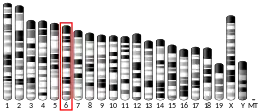Lysyl oxidase homolog 3 is an enzyme that in humans is encoded by the LOXL3 gene.[5][6]
This gene encodes a member of the lysyl oxidase gene family. The prototypic member of the family is essential to the biogenesis of connective tissue, encoding an extracellular copper-dependent amine oxidase that catalyses the first step in the formation of crosslinks in collagens and elastin. A highly conserved amino acid sequence at the C-terminus end appears to be sufficient for amine oxidase activity, suggesting that each family member may retain this function. The N-terminus is poorly conserved and may impart additional roles in developmental regulation, senescence, tumor suppression, cell growth control, and chemotaxis to each member of the family. Alternatively spliced transcript variants of this gene have been reported but their full-length nature has not been determined.[6]
Clinical significance
An autosomal recessive mutation (missense variant) in the LOXL3 gene is one of the causes of Stickler syndrome, a disease where collagen is not crosslinked properly. Common features are high myopia and cleft palate due to arthropathy (joint pathology) and vitreoretinopathy (pathology of the eye).[7]
See also
References
- 1 2 3 GRCh38: Ensembl release 89: ENSG00000115318 - Ensembl, May 2017
- 1 2 3 GRCm38: Ensembl release 89: ENSMUSG00000000693 - Ensembl, May 2017
- ↑ "Human PubMed Reference:". National Center for Biotechnology Information, U.S. National Library of Medicine.
- ↑ "Mouse PubMed Reference:". National Center for Biotechnology Information, U.S. National Library of Medicine.
- ↑ Jourdan-Le Saux C, Tomsche A, Ujfalusi A, Jia L, Csiszar K (Jun 2001). "Central nervous system, uterus, heart, and leukocyte expression of the LOXL3 gene, encoding a novel lysyl oxidase-like protein". Genomics. 74 (2): 211–8. doi:10.1006/geno.2001.6545. PMID 11386757.
- 1 2 "Entrez Gene: LOXL3 lysyl oxidase-like 3".
- ↑ Alzahrani F, Al Hazzaa SA, Tayeb H, Alkuraya FS (2015). "LOXL3, encoding lysyl oxidase-like 3, is mutated in a family with autosomal recessive Stickler syndrome". Hum. Genet. 134 (4): 451–3. doi:10.1007/s00439-015-1531-z. PMID 25663169. S2CID 9869276.
Further reading
- Molnar J, Fong KS, He QP, et al. (2003). "Structural and functional diversity of lysyl oxidase and the LOX-like proteins". Biochim. Biophys. Acta. 1647 (1–2): 220–4. doi:10.1016/s1570-9639(03)00053-0. PMID 12686136.
- Csiszar K (2001). "Lysyl oxidases: a novel multifunctional amine oxidase family". Prog. Nucleic Acid Res. Mol. Biol. Progress in Nucleic Acid Research and Molecular Biology. 70: 1–32. doi:10.1016/S0079-6603(01)70012-8. ISBN 978-0-12-540070-1. PMID 11642359.
- Akagawa H, Narita A, Yamada H, et al. (2007). "Systematic screening of lysyl oxidase-like (LOXL) family genes demonstrates that LOXL2 is a susceptibility gene to intracranial aneurysms". Hum. Genet. 121 (3–4): 377–87. doi:10.1007/s00439-007-0333-3. PMID 17287949. S2CID 25771968.
- Lee JE, Kim Y (2007). "A tissue-specific variant of the human lysyl oxidase-like protein 3 (LOXL3) functions as an amine oxidase with substrate specificity". J. Biol. Chem. 281 (49): 37282–90. doi:10.1074/jbc.M600977200. PMID 17018530.
- Peinado H, Del Carmen Iglesias-de la Cruz M, Olmeda D, et al. (2006). "A molecular role for lysyl oxidase-like 2 enzyme in Snail regulation and tumor progression". EMBO J. 24 (19): 3446–58. doi:10.1038/sj.emboj.7600781. PMC 1276164. PMID 16096638.
- Strausberg RL, Feingold EA, Grouse LH, et al. (2003). "Generation and initial analysis of more than 15,000 full-length human and mouse cDNA sequences". Proc. Natl. Acad. Sci. U.S.A. 99 (26): 16899–903. Bibcode:2002PNAS...9916899M. doi:10.1073/pnas.242603899. PMC 139241. PMID 12477932.
- Huang Y, Dai J, Tang R, et al. (2001). "Cloning and characterization of a human lysyl oxidase-like 3 gene (hLOXL3)". Matrix Biol. 20 (2): 153–7. doi:10.1016/S0945-053X(01)00124-X. PMID 11334717.
- Mäki JM, Kivirikko KI (2001). "Cloning and characterization of a fourth human lysyl oxidase isoenzyme". Biochem. J. 355 (Pt 2): 381–7. doi:10.1042/0264-6021:3550381. PMC 1221749. PMID 11284725.



